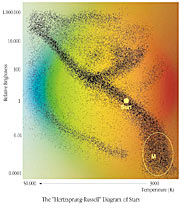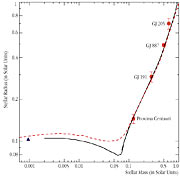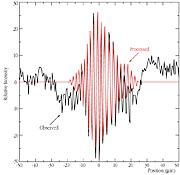Communiqué de presse
How Small are Small Stars Really?
VLT Interferometer Measures the Size of Proxima Centauri and Other Nearby Stars
29 novembre 2002
At a distance of only 4.2 light-years, Proxima Centauri is the nearest star to the Sun currently known [2]. It is visible as an 11-magnitude object in the southern constellation of Centaurus and is the faintest member of a triple system, together with Alpha Centauri, the brightest (double) star in this constellation. Proxima Centauri is a very-low-mass star, in fact barely massive enough to burn hydrogen to helium in its interior. It is about seven times smaller than the Sun, and the surface temperature is "only" about 3000 degrees, about half of that of our own star. Consequently, it is also much fainter - the intrinsic brightness is only 1/150th of that of our Sun. Low-mass stars are very interesting objects , also because the physical conditions in their interiors have much in common with those of giant planets, like Jupiter in our solar system. A determination of the sizes of the smallest stars has been impossible until now because of their general faintness and lack of adequate instrumentation. However, astronomers have long been keen to move forward in this direction, since such measurements would provide indirect, crucial information about the behaviour of matter under extreme conditions. When the first observations with the VLT Interferometer (VLTI), combining the light from two of the 8.2-m VLT Unit Telescopes (ANTU and MELIPAL), were made one year ago, interferometric measurements were also obtained of Proxima Centauri . They formed part of the VLTI commissioning and the data were soon released to the ESO community, cf. the special website. Now, an international team of astronomers from Switzerland, France and ESO/Chile has successfully analysed these observations by means of newly developed, advanced software. For the first time ever, they obtained a highly accurate measurement of the size of such a small star. Three other small stars were also measured and the results are in excellent agreement with stellar theory, indicating that our present understanding of the structure and composition of very small stars is reasonably correct . More VLTI observations are soon to follow, eventually also of even smaller objects, like Brown Dwarfs.
Proxima Centauri - barely a real star
From its spectrum, Proxima Centauri is classified as a "late M-dwarf star". Such stars are among the smallest and faintest, but also the most numerous in our Milky Way galaxy. ESO Press Photo eso0232 displays their particular location relative to other stars in a famous astronomical presentation of basic stellar parameters, known as the "Hertzsprung-Russell (HR) diagram" [3]. Here, stellar temperatures are plotted against brightness to yield a typical distribution that also represents the diverse stages of stellar evolution and ages.
M-dwarfs like Proxima Centauri are located in the cool and faint corner, at the lower right of this diagram. They define the bottom of the diagonal band referred to as the "main sequence" that is occupied by hydrogen-burning stars.
With a mass of only 15% of that of the Sun, Proxima Centauri is in the extreme low-mass end of the M-stars. In fact, if it had only half of its present mass, it would be too light for hydrogen fusion to ignite in its interior. It would then have been a "Brown-Dwarf" rather than a real star.
In the border zone between real stars, brown dwarfs and planets
For a normal star like the Sun whose matter behaves like a perfect gas, the stellar size is proportional to the mass. However, for low-mass stars like Proxima Centauri, quantum effects become important and the stellar matter becomes "degenerate", resisting compression much more than does a perfect gas. For objects with half the mass of Proxima Centauri or lighter, the matter is fully degenerate and their size does not depend on the mass.
In the case of Proxima Centauri, both the mass and the diameter are about 1/7 of those of the Sun. Contrarily, while it is 150 times more massive than Jupiter, it is only about 1.5 times larger than that planet.
Its location in the border zone between stars, brown dwarfs, and planets, makes Proxima Centauri a highly interesting object. A direct measurement of its size, until now impossible because of instrumental limitations, would represent a significant contribution to the study of the physics in this critical transition region.
The VLT interferometric measurements
This kind of measurement has now become possible, thanks to the VLT Interferometer, the VINCI instrument and new software for the complicated data analysis.
Observations were made of Proxima Centauri and three other small stars, soon after the light beams from ANTU and MELIPAL, two of the 8.2-m VLT telescopes, were first brought together in the VLT Interferometric Laboratory at the top of the Paranal mountain.
The VLTI, working with the two large VLT telescopes separated by 102.4 metres (when the moveable 1.8-m telescopes become operational, the maximum baseline will be 202 metres), provides the image sharpness needed to resolve such small stellar disks, and these telescopes are sufficiently large to observe fainter objects than what can normally be studied interferometrically.
The measured angular diameter of Proxima Centauri is 1.02 ± 0.08 milliarcsec, or about the size of an astronaut on the surface of the Moon as seen from the Earth (or a head of a pin on the surface of the Earth, as seen from the International Space Station).
Didier Queloz of the Geneva Observatory is content: "The measured sizes agree well with theoretical predictions, based on numerical models of planets and low-mass stars. The same holds for the sizes of a number of more massive stars that were measured at the same time. This gives us new confidence in the models of these extreme objects."
The use of wavelets
These new results did not come easily, though. The early VLTI data need very extensive processing before they can be astrophysically interpreted. One specific problem is that the two large telescopes here used (without which it would not have been possible to observe such a faint star) have not yet been equipped with "adaptive optics" to eliminate the effects of the turbulence in the Earth's atmosphere [4]. This strongly affects the interferometric measurements by adding "noise".
This particular difficulty had to be solved before the present observational data could be used, cf. ESO Press Photo eso0232 . "We overcame the problem by means of a novel technique based on so-called 'wavelet analysis' and specially developed for the present purpose", explains Damien Ségransan of the Geneva Observatory, "it is a mathematical device we took over from fluid mechanics - another demonstration of how we astronomers keep our eyes open for useful developments in other fields!".
Prospects
This new scientific result, one of the first obtained with the VLT Interferometer, is a fine achievement of this new facility, especially when considering that it was obtained already during tests with the VINCI instrument that was designed to verify the functionality of the VLTI. With the coming installation of more performing and specialized instruments like the Mid-Infrared interferometric instrument for the VLTI (MIDI) and near-infrared/red VLTI focal instrument (AMBER) , the possibility to use also the four 1.8-m Auxiliary Telescopes, as well as the introduction of Adaptive Optics systems for the VLT Unit Telescopes, the astronomers now hope to move quickly forward towards the direct detection of short-period extra-solar planets with the VLTI.
Notes
[1]: This press release is issued in coordination between ESO and the Geneva University in Switzerland.
[2]: Proxima Centauri , the nearest known star to the solar system, is a member of a triple stellar system that includes the bright double star Alpha Centauri . Proxima is the nearest of the three. It was discovered in 1894 by a Scottish astronomer, Robert Thorburn Ayton Innes (1861 - 1915), during a stay at the Cape Observatory (South Africa), due to its very fast motion on the sky, about 3.9 arcsec/year. It is also designated GJ 551 , the 551st entry in the "Catalogue of Nearby Stars", published in 1969 by two German astronomers, Wilhelm G liese (1915-93) and Helmut J ahreis . The visual magnitude is 11, or 100 times fainter than what can be perceived with the unaided eye on a dark sky; the parallax measured by the ESA Hipparcos astrometric satellite is 772.33 ± 2.42 milliarcsec, corresponding to a distance of 4.22 light-years.
[3]: The "Hertzsprung-Russell" diagram is named after the Danish astronomer Einar Hertzsprung (1873-1967) and the American astronomer Henry Norris Russell (1877 - 1957). At the beginning of the 20th century they independently noticed that red stars come in very different sizes, pioneering subsequent studies of stellar parameters (e.g., temperature, size and mass). In its basic version, this diagram plots stellar temperature (or colour) against brightness (or magnitude) and is therefore also referred to as the "colour-magnitude diagram". The position of a particular star in the diagram also provides information about its evolutionary stage (and age).
[4]: The first Adaptive Optics instruments for the VLT Interferometer will be installed in 2003.
Plus d'informations
The information presented in this Press Release is based on a Letter to the Editor ("First radius measurements of very low mass stars with the VLTI" by Damien Ségransan (Geneva Observatory), Pierre Kervella (ESO Chile), Thierry Forveille (Observatoire de Grenoble - Canada-France-Hawaii-Telescope [CFHT]) and Didier Queloz (Geneva Observatory) - see also http://obswww.unige.ch/~segransa/proxima.html - that will soon appear in the European research journal "Astronomy & Astrophysics".
More information about the VLTI and photos of many of the components of the facility are available at the VLTI website, as well as in eso0111 ("First Light" in March 2001 and explanation of the interferometric measurements), eso0133 (observations with two 8.2-m telescopes in October 2001) and eso0225 (observations with four 8.2-m telescopes in September 2002).
Contacts
Didier Queloz
Observatoire de Genève
Sauverny, Switzerland
Tél: +41-22-755-2611
Courriel: didier.queloz@obs.unige.ch
A propos du communiqué de presse
| Communiqué de presse N°: | eso0232 |
| Legacy ID: | PR 22/02 |
| Nom: | GJ 887, Proxima Centauri |
| Type: | Milky Way : Star |
| Facility: | Very Large Telescope, Very Large Telescope Interferometer |
| Instruments: | VINCI |
| Science data: | 2003A&A...397L...5S |
Our use of Cookies
We use cookies that are essential for accessing our websites and using our services. We also use cookies to analyse, measure and improve our websites’ performance, to enable content sharing via social media and to display media content hosted on third-party platforms.
ESO Cookies Policy
The European Organisation for Astronomical Research in the Southern Hemisphere (ESO) is the pre-eminent intergovernmental science and technology organisation in astronomy. It carries out an ambitious programme focused on the design, construction and operation of powerful ground-based observing facilities for astronomy.
This Cookies Policy is intended to provide clarity by outlining the cookies used on the ESO public websites, their functions, the options you have for controlling them, and the ways you can contact us for additional details.
What are cookies?
Cookies are small pieces of data stored on your device by websites you visit. They serve various purposes, such as remembering login credentials and preferences and enhance your browsing experience.
Categories of cookies we use
Essential cookies (always active): These cookies are strictly necessary for the proper functioning of our website. Without these cookies, the website cannot operate correctly, and certain services, such as logging in or accessing secure areas, may not be available; because they are essential for the website’s operation, they cannot be disabled.
Functional Cookies: These cookies enhance your browsing experience by enabling additional features and personalization, such as remembering your preferences and settings. While not strictly necessary for the website to function, they improve usability and convenience; these cookies are only placed if you provide your consent.
Analytics cookies: These cookies collect information about how visitors interact with our website, such as which pages are visited most often and how users navigate the site. This data helps us improve website performance, optimize content, and enhance the user experience; these cookies are only placed if you provide your consent. We use the following analytics cookies.
Matomo Cookies:
This website uses Matomo (formerly Piwik), an open source software which enables the statistical analysis of website visits. Matomo uses cookies (text files) which are saved on your computer and which allow us to analyze how you use our website. The website user information generated by the cookies will only be saved on the servers of our IT Department. We use this information to analyze www.eso.org visits and to prepare reports on website activities. These data will not be disclosed to third parties.
On behalf of ESO, Matomo will use this information for the purpose of evaluating your use of the website, compiling reports on website activity and providing other services relating to website activity and internet usage.
Matomo cookies settings:
Additional Third-party cookies on ESO websites: some of our pages display content from external providers, e.g. YouTube.
Such third-party services are outside of ESO control and may, at any time, change their terms of service, use of cookies, etc.
YouTube: Some videos on the ESO website are embedded from ESO’s official YouTube channel. We have enabled YouTube’s privacy-enhanced mode, meaning that no cookies are set unless the user actively clicks on the video to play it. Additionally, in this mode, YouTube does not store any personally identifiable cookie data for embedded video playbacks. For more details, please refer to YouTube’s embedding videos information page.
Cookies can also be classified based on the following elements.
Regarding the domain, there are:
- First-party cookies, set by the website you are currently visiting. They are stored by the same domain that you are browsing and are used to enhance your experience on that site;
- Third-party cookies, set by a domain other than the one you are currently visiting.
As for their duration, cookies can be:
- Browser-session cookies, which are deleted when the user closes the browser;
- Stored cookies, which stay on the user's device for a predetermined period of time.
How to manage cookies
Cookie settings: You can modify your cookie choices for the ESO webpages at any time by clicking on the link Cookie settings at the bottom of any page.
In your browser: If you wish to delete cookies or instruct your browser to delete or block cookies by default, please visit the help pages of your browser:
Please be aware that if you delete or decline cookies, certain functionalities of our website may be not be available and your browsing experience may be affected.
You can set most browsers to prevent any cookies being placed on your device, but you may then have to manually adjust some preferences every time you visit a site/page. And some services and functionalities may not work properly at all (e.g. profile logging-in, shop check out).
Updates to the ESO Cookies Policy
The ESO Cookies Policy may be subject to future updates, which will be made available on this page.
Additional information
For any queries related to cookies, please contact: pdprATesoDOTorg.
As ESO public webpages are managed by our Department of Communication, your questions will be dealt with the support of the said Department.




